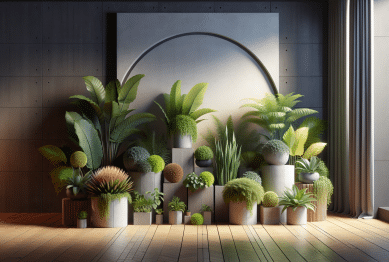Discover the art of designing a low maintenance garden that thrives with less work. This guide uncovers how smart plant choices, efficient watering, and sustainable landscaping can transform any outdoor space into an oasis. Enjoy practical strategies on gardening success for busy lifestyles.
Why Low Maintenance Gardening Appeals to Everyone
Low maintenance gardening is more than a passing trend—it’s a lifestyle change embraced by those who crave outdoor beauty without hours of weeding and trimming. Homeowners appreciate the value of a garden that practically takes care of itself, creating a relaxing retreat instead of a weekend chore list. Many find that starting with hardy perennials and ground covers truly eliminates the need for constant replanting or seasonal fuss. The promise of a thriving outdoor environment that saves time and water appeals to families, seniors, and working professionals alike.
Several reasons drive the popularity of easy-care gardens, including changing weather patterns, water restrictions, and busy urban routines. Introducing native plants or drought-resistant varieties has helped numerous people adapt their landscapes for resilience and eco-friendliness. The pride in watching pollinators visit flowering shrubs, or children enjoying the lawn, shows that low-care gardens deliver joy and function together. By reducing labor, these gardens also cut back on chemical use, boosting safety for kids and pets. The shift to sustainable solutions is as much about peace of mind as it is about convenience.
Lower maintenance doesn’t mean no care at all. Instead, effective planning and design make chores like pruning, mowing, or watering less frequent and more straightforward. This often leads to healthier soils, increased biodiversity, and beautiful corners year-round. People find that investment in mulching, drip irrigation, and well-placed foliage pays off over time, both for their energy and the planet. The satisfaction of seeing a vibrant space flourish with minimal input is a major reward for adopting this approach.
Choosing Plants for Effortless Beauty
Plant selection is the heart of a truly low maintenance landscape. Natives are a foolproof choice for many, as they’re naturally suited to local conditions. These plants establish deeply and resist pests, requiring little more than annual clean-up once mature. Some gardeners recommend mixing evergreen shrubs with perennial flowers to ensure color and shape even during winter. Ever noticed how ornamental grasses sway gracefully yet almost never need attention? Smart plant pairings offer texture, movement, and lasting interest with less watering and pruning.
Drought-tolerant species like lavender, sedum, and yarrow have become favorites in areas facing water use limitations. These robust varieties thrive in lean soils and rarely ask for fertilization. Many enthusiasts rave about how easily daylilies, hostas, and coneflowers fill a bed for years with minimal fuss. Groundcovers such as creeping thyme or vinca minor spread quickly to shade out weeds and prevent soil erosion. Selecting plants for your climate and sun exposure—rather than just their looks—saves on replacement and surprise pest problems later.
Clustered plantings and repetition can simplify ongoing chores. Grouping the same species encourages mass color display, which lends visual unity with less trimming or deadheading. In shade spots, ferns and hellebores return reliably each season, even with heavy rain or summer heat. For sunny spaces, succulents or Mediterranean herbs blend decorative flair and drought survival. Mixing textures and bloom times produces continuous interest while letting the garden take care of itself for the most part. Many garden centers provide lists of reliable options for local environments—explore these resources for proven, low-fuss ideas.
Reducing Water Needs and Improving Irrigation
One cornerstone of easy gardening is finding water-wise solutions. Efficient irrigation, such as drip or soaker hoses, targets roots directly and results in far less waste than traditional sprinklers. These tools keep moisture at ground level, discouraging fungal problems and making watering schedules much easier to manage. Collecting rainwater in barrels and using mulch to keep soils cool are time-tested practices for conserving resources. Many people report dramatic reductions in utility bills after switching to these methods, without compromising plant health.
Soil improvement plays a vital role in watering efficiency. Adding organic matter, like compost or shredded leaves, ensures the ground retains moisture while letting roots breathe. Using mulch to a depth of two to three inches keeps competing weeds at bay and shields soil from harsh sunlight. Experts recommend checking soil conditions before irrigating—only water when needed, not on a set routine. Observing plant signals, such as wilting or changing leaf color, helps gardeners respond to real needs rather than guesswork.
Automating your irrigation system can maximize effectiveness with minimal oversight. Timers and smart systems sense rainfall, shutting off automatically to prevent overwatering. Many brands now sync with home Wi-Fi or weather forecasts, adjusting to local climate in real time. This leaves more time to enjoy your garden while optimizing plant hydration. These strategies not only benefit your garden but also support regional conservation efforts and promote healthy ecosystems in your neighborhood.
Design Tricks for Effortless Outdoor Spaces
Good design is the secret to a garden that looks amazing but needs very little upkeep. Curved pathways, generous plant beds, and layered heights guide the eye, creating drama without demanding weekly mowing or weeding. Raised beds can define areas and make caring for vegetables and flowers much less of a chore. A simple stone patio or gravel seating zone doubles as both a low-key entertainment space and a weed barrier. Every feature should serve a purpose, whether as a focal point or as practical infrastructure for easy care.
Many homeowners find that guiding rainwater with swales or permeable paving reduces flooding and makes planting areas self-sufficient. Breaking up large lawn areas with clusters of shrubs or ornamental trees lowers mowing time and offers valuable habitat to birds and pollinators. Decorative boulders, benches, and even art pieces can define space and structure without adding maintenance. Choosing features wisely helps keep both upfront costs and long-term upkeep in check.
Entryways, fences, and privacy screens constructed from durable, weather-resistant materials need less repair and cleaning year after year. Consider the trend of using native rock or recycled elements to build walls and garden edges—these materials add visual interest and blend naturally with the landscape. Solar lighting and automatic timers reduce manual chores while inviting safe movement in the evening. Every thoughtful design step you take at the beginning saves repeated effort down the line and makes your outdoor area truly rewarding.
Smart Maintenance Strategies for Lasting Results
Even the easiest gardens need a little attention. Mowing less often and letting grass grow longer shades soil and conserves water. Sharpening tools at the start of each season can make quick work of trimming and cut back on plant injuries. Some gardeners favor monthly walk-throughs to check for pests or prune overgrown branches, rather than waiting for problems to multiply. Small, consistent actions keep things looking fresh without major weekend effort.
Fertilizing plants with compost rather than synthetic products builds long-term soil health and biodiversity underground. Leaf litter, grass clippings, and other garden waste can be recycled directly onto beds, feeding beneficial organisms. Testing soil every year or two provides a roadmap for what amendments are truly needed, avoiding unnecessary expenses and preventing run-off. Weed control is best done with deep mulch layers or fabric, discouraging new seedlings instead of relying on constant spraying.
Gloves, ergonomic tools, and raised bed edges can make routine jobs safer and more comfortable. Reducing the physical strain of maintenance helps people of all ages keep gardening a lifelong passion. Many people set reminders to check irrigation systems, remove volunteer seedlings, or refresh mulch at the start of each season. Organizing supplies in an accessible shed cuts back on wasted time. In this way, smart strategies replace major spring cleanups with enjoyable, bite-sized tasks.
Benefits Beyond the Backyard
The rewards of low maintenance gardening ripple outward beyond personal enjoyment. Reducing chemical and water use supports neighborhoods by encouraging pollinators, restoring soil health, and preventing stormwater runoff. Public health experts highlight that sustainable gardens also promote outdoor activity, community gathering, and connection with nature. The ripple effect can be seen when more neighbors adopt similar principles, building resilient and attractive spaces throughout the community.
Many cities and local groups now offer workshops and incentives for transitioning yards to sustainable landscapes. This movement reduces mowing noise, air pollution from gas engines, and landfill burdens from yard waste. Even simple refreshes, such as converting a side yard into a pollinator patch, bring lasting ecological benefits and offer hands-on learning for children. The cumulative impact of many individuals making small changes can transform an entire area.
Importantly, these gardens create homes for wildlife—bees, butterflies, songbirds—that rely on connected habitats for survival. Learning about beneficial insects and healthy soil communities adds another rich layer to the gardening experience. Restorative green spaces also buffer against extreme weather, making neighborhoods cooler in summer and absorbing stormwater. The legacy of a thoughtfully planned, low-maintenance garden is both personal and collective, benefitting owners, neighbors, and the natural world alike.
References
1. United States Environmental Protection Agency. (n.d.). Green Landscaping: Greenacres. Retrieved from https://www.epa.gov/greenacres
2. Missouri Botanical Garden. (n.d.). Native Plants for Midwest Gardens. Retrieved from https://www.missouribotanicalgarden.org/plantfinder/plantfindersearch.aspx
3. Royal Horticultural Society. (n.d.). Drought-Resistant Gardening Advice. Retrieved from https://www.rhs.org.uk/garden-advice/profile/library/drought-resistant-gardening
4. Sustainable Gardening Australia. (n.d.). Waterwise Gardening. Retrieved from https://www.sgaonline.org.au/waterwise-gardening
5. National Wildlife Federation. (n.d.). Garden for Wildlife. Retrieved from https://www.nwf.org/Garden-for-Wildlife
6. Cornell University Cooperative Extension. (n.d.). Easy-Care Landscape Plants. Retrieved from https://gardening.cals.cornell.edu/garden-guidance/easy-care-landscape-plants/









